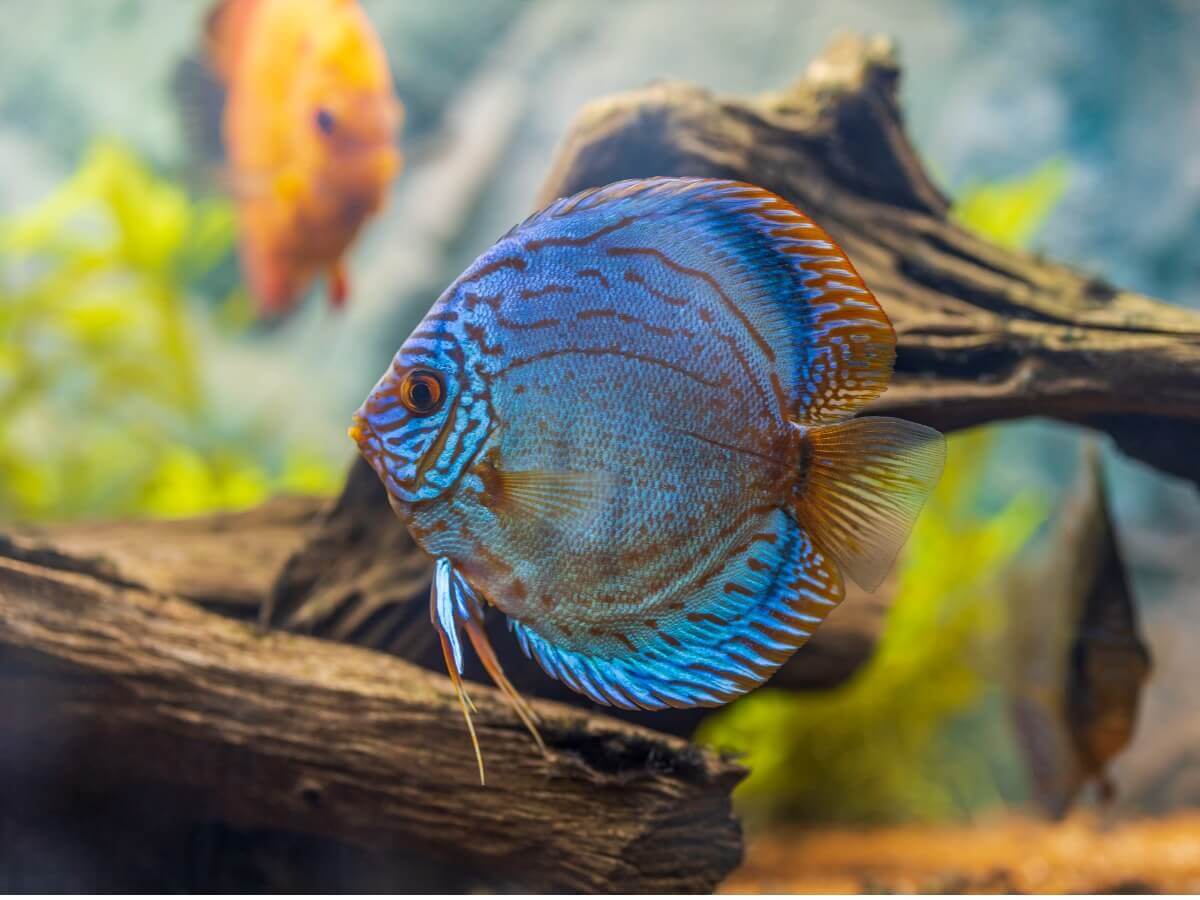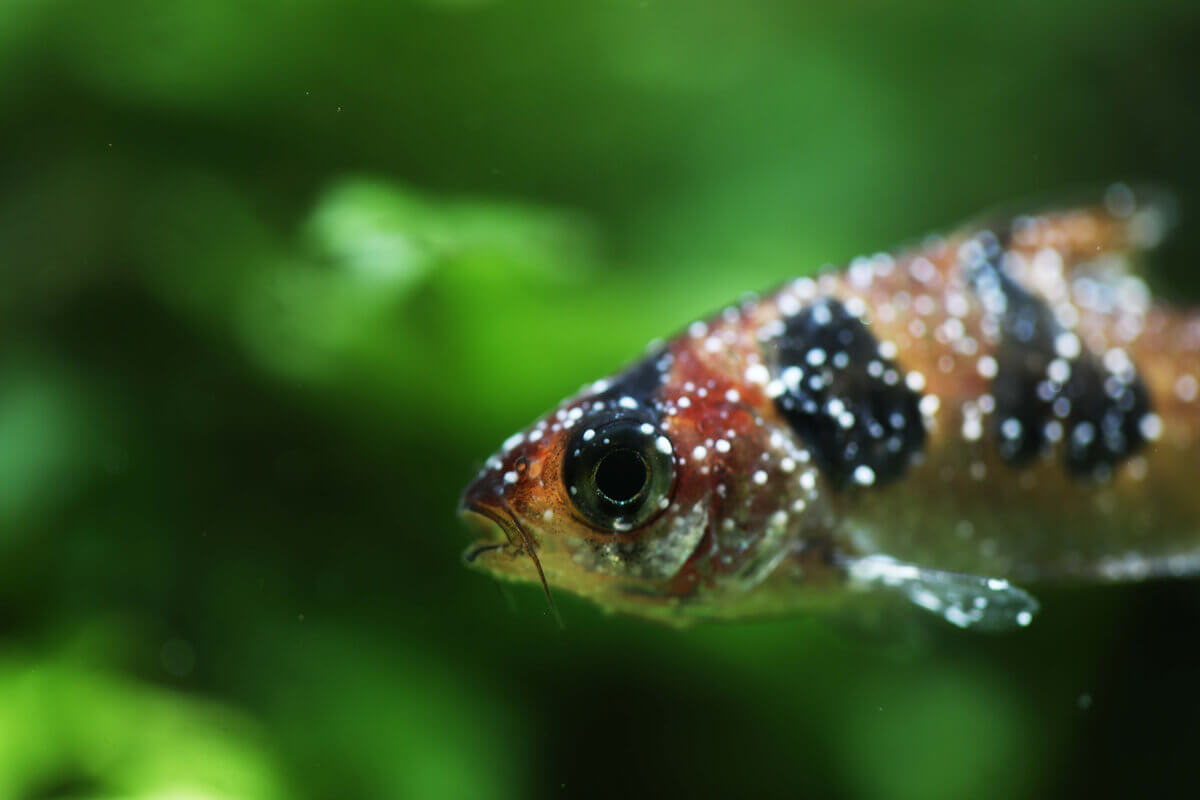My Fish Has a White Coating on its Body: What Is It?


Written and verified by the biologist Samuel Sanchez
Aquariums are a true sensory joy, bringing peace, aesthetics, freshness, and beauty to any room in which they’re placed. Watching the fish swim peacefully around the tank is mesmerizing, isn’t it? However, a lot can go wrong in this little ecosystem. For example, you may see that a fish has a white coating on its body.
Whether mucous or a foreign substance, an opaque or milky film on the animal’s body always indicates an illness (usually serious). If you want to know how to deal with such a difficult situation, read on.
The mucous layer of fish
As studies show, the epidermis of fish is covered with a slippery, slimy substance known as mucus. This is the first biological barrier that acts as a protection against viruses, bacteria, and more complex ectoparasites (such as copepod crustaceans of the genus Lernaea or anchor worms).
This viscous colloid contains antibacterial factors, including antimicrobial peptides (AMPs), lysozymes, lectins, proteases, and other compounds that give the fish some innate immunity. The mucus prevents the adherence of pathogens, but also actively fights against them and can even destroy them.
Beyond this, the viscous body of the fish has a clear displacement function. It allows these vertebrates to move more easily in the aqueous environment, as it reduces the resistance and friction produced during underwater swimming.
As expected, the condition of this mucous layer indicates (to some extent) the degree of health of the fish. When it becomes opaque or lesions develop, it’s safe to assume that the fish is suffering from some sort of disease, either epidermal or systemic.
The mucous layer of the fish improves its hydrodynamic capacity and actively protects it against pathogens.

Why does my fish have a white coating on its body?
The mucous layer protects fish from infection, but it’s not foolproof or indestructible. Poor water quality, overcrowding, constant stress, and inadequate food will make it easier for your fish to catch various pathogens. Here are 3 reasons why your fish has a white coating on its body and how to deal with them.
1. Velvet disease
This condition is caused by a group of microscopic dinoflagellates of the genus Oodinium. These parasites can be distinguished under the microscope by the presence of 2 flagella, one of which disappears transversely when the parasite is attached by pseudopods to the epidermis of the fish. Their reproduction is asexual and some have a free-living phase.
The cycle of these organisms is quite complex, but it’s enough to know that the tomites (infective juvenile forms) move freely until they reach their host, which they parasitize by adhering to its skin and integrating into its mucosa. They feed on the cells, which they dissolve with chemical compounds, and become tomonts after 3 days, which divide asexually.
Some of the symptoms of this infection are as follows:
- Scratching (flashing) of the fish against hard objects.
- Lethargy.
- Loss of appetite and weight loss.
- Rapid and labored breathing.
- A whitish or yellowish coating that covers the body of the fish. This gives it a velvety appearance.
- Skin shedding in the most severe stages.
Treatment of infected fish is expensive, and the entire aquarium must be medicated. The first step is to raise the water temperature to 86 °F (if the species is tropical), but you also need to buy special medicines with copper sulfate and follow the treatment closely for about 10 days.
It’s important to remove the charcoal filter from the tank during this treatment process.
2. Slime disease
Slime disease refers to a general clinical picture more than a specific infection. This term refers to any disease that causes a thickening and opacity in the natural mucous layer of the fish. This gives it a general milky and sickly appearance.
Lethargy, loss of appetite, lack of movement, and atypical breathing are signs that accompany the condition that concerns us here. In this case, you need to see a veterinarian, as the condition may be due to various bacterial, viral, and fungal pathogens. In other words, it has no specific etiology.
Without a doubt, this group of conditions is the most common cause of a fish having a white coating on its body. White spot and velvet disease are also suspected in many cases but cause a more pearly or speckled appearance.
3. White spot disease
Another cause of a fish having a white film covering its body is white spot disease. However, rather than a uniform film, these are round and very whitish dots that are visible to the touch. These correspond to microorganisms of the species Ichthyophthirius multifiliis (a ciliated parasite) encysted in the skin of the fish.
At the biological level, these spots respond to trophozoites, infective forms that are feeding on the skin of the fish. When these are released, they become encysted elsewhere in the aquarium and acquire the name of tomocysts (tomonts), which eventually rupture and release up to 1000 free-living tomocytes. The tomocysts mature into trophonts and the cycle is repeated.
The symptoms of this disease are very similar to those already mentioned in other diseases and sometimes its symptomology is confused with velvet disease. Formalin is usually the chemical compound of choice to treat the entire aquarium, although copper sulfate, methylene blue, and potassium permanganate (always specific for aquariums) can also be used.
If left untreated, white spot disease has a lethality rate of up to 100%.

Various clinical conditions can cause your fish to have a white coating on its body. We recommend that you go to the vet in all cases, as this clinical sign is quite general and sometimes there’s no specific cause (it can have to do with more than one infection at a time). If you don’t act, it’s likely that your entire aquarium will soon become infected.
All cited sources were thoroughly reviewed by our team to ensure their quality, reliability, currency, and validity. The bibliography of this article was considered reliable and of academic or scientific accuracy.
- Dash, S., Das, S. K., Samal, J., & Thatoi, H. N. (2018). Epidermal mucus, a major determinant in fish health: a review. Iranian Journal of Veterinary Research, 19(2), 72.
- Tema 3, orden Dinoflagelida (PDF). Recogido a 13 de octubre en https://www2.ulpgc.es/hege/almacen/download/35/35429/tema_3.pdf
- Velvet in fish, The Spruce Pets. Recogido a 13 de octubre en https://www.thesprucepets.com/aquarium-fish-disease-velvet-1378486
This text is provided for informational purposes only and does not replace consultation with a professional. If in doubt, consult your specialist.